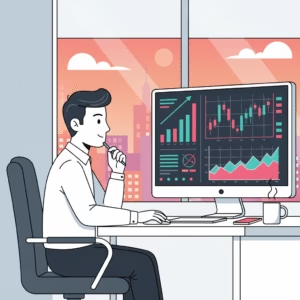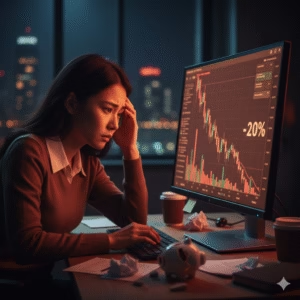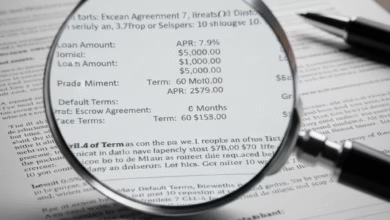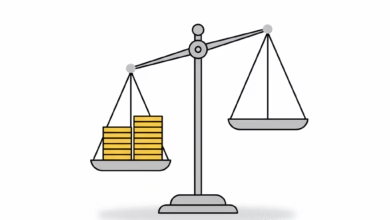Why do investors tend to buy high and sell low?
Understand how many investors sometimes buy an expensive stock and sell it cheap.

Ask any successful investor the #1 rule of the market, and they’ll tell you the same, simple adage: “Buy low, sell high.”
It’s the most basic principle of wealth creation. You buy an asset when it’s cheap, you wait for its value to increase, and you sell it for a profit. It’s simple, it’s obvious, and it’s taught in every finance class.
So, why is the most common mistake in all of investing the exact, polar opposite?
For decades, data has shown that the average retail investor consistently underperforms the market. The primary reason? They don’t buy low and sell high. They buy high and sell low. They pile into an investment after it has already seen massive gains, and they panic-sell it after it has crashed.
This isn’t a failure of intelligence. It’s a failure of human psychology. Your brain, which evolved to protect you from predators on the savanna, is hardwired to make the worst possible decisions at the worst possible times.
This article isn’t about stock tips. It’s about understanding the deep-seated, emotional triggers that cause this self-destructive cycle. Once you can see the puppet strings of fear and greed pulling at you, you can finally learn to cut them.
The Emotional Pendulum: What Is the “Buy High, Sell Low” Cycle?

The stock market is often described as a pendulum that swings between two extremes: Euphoric Greed and Paralyzing Fear. The “Buy High, Sell Low” cycle is what happens when investors ride this pendulum all the way to the top, and all the way to the bottom.
Here is what the disastrous cycle looks like:
- The Start (Optimism): A stock or market (like the S&P 500) starts to recover from a low. Smart, disciplined investors see value and begin to “buy low.” Most people, however, are still too scared from the last crash and sit this part out, calling it a “sucker’s rally.”
- The Climb (Excitement): The market keeps rising. The media starts to cover it. Your friends and coworkers start talking about the money they’re making. You start to feel a prickle of interest… and a little bit of regret for missing out.
- The Peak (Euphoria & Greed): This is the danger zone. The market is at an all-time high. Headlines are celebratory. Everyone you know is a “stock market genius.” The feeling of FOMO (Fear of Missing Out) becomes unbearable. You finally jump in, investing a large sum of money because it finally feels “safe.” You have just bought high.
- The Turn (Anxiety): The market begins to fall. Your “sure thing” is now down 10%. You tell yourself it’s a “temporary dip” and a “buying opportunity,” but you’re too nervous to buy more.
- The Plunge (Fear & Denial): The market is now down 30%. The news is turning negative. Your friends are no longer talking about their “genius” picks. You start frantically checking your portfolio every 10 minutes.
- The Bottom (Panic & Capitulation): The market is down 50%. The headlines are apocalyptic: “The End of Capitalism,” “The New Great Depression.” The pain is unbearable. Your brain’s ancient survival instinct screams at you to “GET TO SAFETY.” You can’t take it anymore. You sell everything, just to “make the pain stop.” You have just sold low.
The cycle is now complete. You have successfully locked in a permanent 50% loss. And what happens next? The market, now cleared of all the panic-sellers, begins its slow, optimistic climb once again, starting the cycle over… without you.
The “Buy High” Trap: Unpacking the Psychology of Greed and FOMO
Why on earth would anyone buy something at its most expensive price? It’s a combination of powerful psychological biases that overwhelm our logic.
FOMO: The Most Expensive Emotion in Finance
Humans are social creatures. We are wired to feel anxiety when we are being left behind by the tribe. In the financial world, this is the Fear of Missing Out (FOMO).
When you see your neighbor, your brother-in-law, or some 20-year-old on TikTok bragging about their 500% gains on a “meme stock,” you don’t feel happy for them. You feel behind. You feel a primal urge to jump in, not because you’ve analyzed the asset, but because you can’t stand the social and financial pain of being the only one not getting rich. This emotional hijack causes you to buy, at any price, just to be part of the crowd.
Herd Mentality and Social Proof: The “Safety” of the Crowd
For 99% of human history, following the herd meant survival. If everyone was running, you didn’t stop to ask “Why?”; you ran, too.
This “social proof” bias is toxic in investing. When everyone is buying, it feels like the safe, correct decision. “If everyone thinks this stock is a winner, it must be,” our brain concludes. The problem is that in finance, by the time “everyone” is in, the smart money is already on its way out. The herd is almost always wrong at the extremes, and by following it, you’re setting yourself up to be the last one holding the bag.
Recency Bias: “The Market Only Goes Up”
Our brains are terrible at long-term thinking. We give far more weight to recent events than to distant ones. This is Recency Bias.
After a 10-year bull market (like the one from 2009 to 2019), our brains start to believe that this is the new normal. We forget that crashes are a regular, healthy part of the market cycle. We get overconfident, believing that stocks only go up. This false sense of security encourages us to take massive risks—like putting all our money in at the top—because our recent experience hasn’t given us any reason to be cautious.
The “Sell Low” Catastrophe: How Fear and Panic Wreck Your Wealth

If buying high is the setup, selling low is the knockout punch. This is where the real, permanent wealth destruction happens.
Loss Aversion: Why Losing Hurts Twice as Much as Winning
This is the single most important concept in behavioral finance, discovered by Nobel Prize-winning psychologists. Loss Aversion is the principle that the pain of a loss is roughly twice as powerful as the pleasure of an equivalent gain.
Losing $1,000 feels as emotionally devastating as finding $2,000 feels good.
When a market crash begins, your portfolio isn’t just numbers on a screen; it’s a source of intense, visceral pain. Your brain isn’t wired to “ride it out.” It’s wired to make the pain stop. Selling your investments is the only way to do that. You aren’t making a financial decision; you’re making an emotional one. You’re taking a painkiller, and the side effect is a catastrophic, permanent loss of your capital.
Confirmation Bias: Seeking News That Confirms Your Terror
Once you start to feel afraid, your brain actively looks for information to validate that fear. This is Confirmation Bias.
You stop reading long-term, optimistic reports and start Googling “is this the next great depression?” The 24/7 financial news cycle—which profits from fear and panic—is more than happy to feed your anxiety. You’ll find a thousand articles and “gurus” predicting the end of the world. This creates a self-reinforcing panic loop, convincing you that your emotional impulse to sell is actually a well-researched, logical decision. It’s not.
The Pain of “Capitulation”
In market terms, “capitulation” is the moment when investors collectively give up. It’s the point of maximum pessimism. It’s when the last “holdout” finally breaks and sells their entire portfolio, vowing “never to invest in the stock market again.”
This moment of peak pain and mass-selling is, almost without fail, the exact bottom of the market. It’s the point of maximum financial opportunity. But the person who just “sold low” will miss it entirely, too emotionally scarred and financially damaged to get back in.
Case Studies in Catastrophe: When America Bought High and Sold Low
This isn’t just theory. This cycle has repeated itself, without fail, in every bubble and crash in history.
Case Study 1: The Dot-Com Bubble (1999-2000)
- The “Buy High”: In 1999, the internet was new and exciting. A “new paradigm” of business was declared. Companies with no revenue, no profits, and no business plan (like Pets.com) were going public and seeing their stock prices triple overnight. It was a classic “Get Rich Quick” frenzy. Millions of ordinary people, gripped by FOMO and greed, poured their life savings into these tech stocks at their absolute peak.
- The “Sell Low”: In March 2000, the bubble burst. The tech-heavy Nasdaq index crashed, falling nearly 80% over the next two years. The same people who had bought at the top, their retirement dreams shattered, sold everything near the bottom, locking in devastating losses.
Case Study 2: The COVID-19 Crash (March 2020)
- The “Sell Low”: This was one of the fastest crashes in history. In February and March 2020, the world shut down. The future was terrifyingly uncertain. The market plunged over 30% in just a few weeks. Driven by pure, unadulterated fear and loss aversion, investors pulled billions of dollars out of the market. They capitulated and sold en masse in late March, at the very bottom.
- The Aftermath: What happened next? The market began one of the sharpest, fastest recoveries in history. The people who panic-sold in March 2020 missed the entire rebound. The disciplined investors who either held on (or were brave enough to buy) saw their wealth skyrocket.
How to Break the Cycle: 5 Strategies for Rational, Disciplined Investing
You cannot change your human brain. You cannot eliminate fear or greed. But you can build a system that protects you from your own worst impulses.
1. Have a Written Investment Plan (Your “Emotional Shield”)
The most important thing you can do is create a simple, written Investment Policy Statement (IPS). Do this when you are calm and rational. It’s a contract with your future, emotional self.
It should answer:
- What is my goal? (e.g., “Retire in 30 years.”)
- What is my strategy? (e.g., “Invest in a diversified, low-cost index fund.”)
- What will I do when the market crashes? (e.g., “I will do nothing. I will not sell. I will continue to buy as planned.”)
When you feel the panic, you must read this plan.
2. Automate Your Investments (Dollar-Cost Averaging)
This is the #1 practical weapon against the “Buy High, Sell Low” cycle. Dollar-Cost Averaging (DCA) is the simple act of investing a fixed amount of money at regular intervals (e.g., $500 from every paycheck).
- When the market is high, your $500 buys fewer shares.
- When the market is low (and scary), your $500 automatically buys more shares.
This simple, automated system forces you to buy low, and it removes the emotional decision-making entirely. You are no longer trying to “time the market”; you are just “in the market.”
3. Understand Your True Risk Tolerance
It’s easy to say you’re an “aggressive investor” in a bull market. The real test is: How would you feel if your portfolio was cut in half? If the answer is “I would panic and sell,” then you are not an aggressive investor, and you should not have 100% of your money in stocks. Be honest with yourself and add bonds or cash to your portfolio to smooth the ride. A “good enough” plan you can stick with is infinitely better than a “perfect” plan you abandon.
4. Diversify. No, Really.
The “Buy High” frenzy is often focused on one or two “hot” stocks (Tesla! GameStop! Pets.com!). This is concentration. It’s gambling. Diversification is the only free lunch in investing. By owning a broad-market index fund (like an S&P 500 or Total World fund), you own thousands of companies. You are protected from a single company failing, and you are guaranteed to capture the market’s long-term return. It’s the “boring” strategy that wins.
5. Log Off and Tune Out the Noise
Stop checking your 401(k) every day. It is not a video game. Stop watching financial “news” networks. Their job is not to make you wealthy; their job is to sell advertising by triggering your fear and greed. The more you watch, the more emotional you will be, and the worse your returns will be. Set up your automatic investments and go live your life.
You Are Your Own Worst Enemy (And Your Own Best Savior)

The stock market is a fascinating machine. It’s a tool for building incredible, generational wealth. But it is also a mirror that reflects our deepest psychological flaws.
It’s designed to separate impatient, emotional people from their money and give it to disciplined, patient people.
The key to long-term success is not a “hot tip” or a complex trading algorithm. It’s mastering the battlefield between your own ears. It’s admitting you are human, acknowledging that you will feel fear and greed, and then building a simple, automated system that makes those feelings irrelevant.
Don’t be the investor who buys high and sells low. Be the investor who builds a plan, automates it, and lets time and compounding do the rest.





